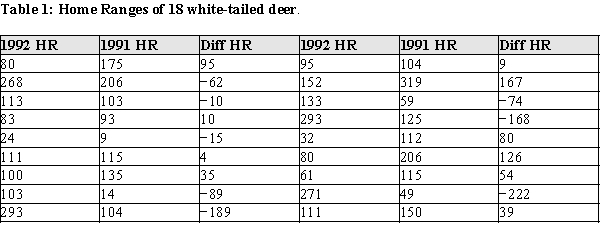Essay
The home range of an animal is the average area an animal occupies while foraging for food and defending its territory. It is thought that home ranges of animals usually do not change much, except when an area is under ecological stress. As part of a study of white-tailed deer in Florida in 1991 and 1992, deer were radiocollared and their movements followed over the course of a year. The home range data for a random sample of 18 white-tailed deer are shown below in Table 1. The raw area of the home range for each of the deer is reported in hectares for the years 1991 and 1992. (A hectare is a metric unit of area equal to 2.471 acres.) The investigators are interested in determining whether the home range white-tailed deer change over the course of as little time as a year. 
a)Using graphical display(s) of your choice show that the assumptions necessary for determining a change in the mean home ranges are plausible.
b)Construct a 95% confidence interval for the difference in means of the home ranges from 1991 to 1992.
c)Do the data provide evidence of a change in the size of the home ranges between 1991 and 1992? Provide statistical justification for y.
Correct Answer:

Verified
a)There is no information that the deer ...View Answer
Unlock this answer now
Get Access to more Verified Answers free of charge
Correct Answer:
Verified
View Answer
Unlock this answer now
Get Access to more Verified Answers free of charge
Q11: In a recent paper, the authors distinguish
Q12: A recent paper described an experiment in
Q13: A common memory task is the classification
Q14: Researchers have hypothesized that female Downy Woodpeckers
Q16: When testing hypotheses about and constructing confidence
Q17: A researcher investigates the effect of a
Q18: For two independent samples, <img src="https://d2lvgg3v3hfg70.cloudfront.net/TB7677/.jpg" alt="For
Q19: As part of the iguana risk assessment
Q20: An article describes a study of the
Q34: The large sample z test for μ<sub>1</sub>